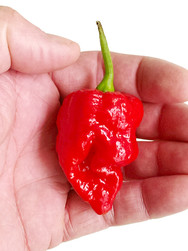Chili Pepper Benefits - The World's Most Hottest Chili Peppers
- Michael Constantine
- Apr 12, 2020
- 8 min read
The chili pepper, from Nahuatl chīlli, is the fruit of plants from the genus Capsicum which are members of the nightshade family, Solanaceae. Chili peppers are widely used in many cuisines as a spice to add heat to dishes.
There are over 3000 Chilli Pepper varieties.
THE CAROLINA REAPER 2,200,000 SHU
As of August, 2013, Guinness World Records stated that Smokin’ Ed’s Carolina Reaper® is officially the world’s hottest chile pepper. Originally named the “HP22BNH7”, this pepper is bred by cultivator Ed Currie, who runs PuckerButt Pepper Company in Fort Mill, South Carolina.

TRINIDAD MORUGA SCORPION 2,000,000 SHU
The New Mexico State University’s Chili Pepper Institute identified the Trinidad Moruga Scorpion as the newest, hottest chili pepper in the world as of February 2012. The current world record holder is the Carolina Reaper. However the Trinidad Moruga Scorpion wasn’t certified as the hottest pepper by the Guinness Book of World Records.

DOUGLAH 1,853,936 SHU
From Trinidad. It’s said that one pod will spice seven pots of stew, hence the name. It is a rare and extremely hot chili. The Douglah is characterized by a dark brown or deep purple skin with many “pimples” over the surface. The pepper starts out green and matures to the dark color unique to the Douglah.

PRIMO 1,473,480 SHU
Created by Troy Primeaux, (nickname: Primo), a horticulturist from Louisiana. He began crossing the Naga Morich and Trinidad 7 Pot seeds around 2005 and has since grown them out for eight generations. The 7 Pot Primo can get very lumpy and distorted and even grow a skinny little tail. Like other 7 Pots it has a fruity-to-floral flavor and is extremely hot. Orange and yellow varieties of this pepper have also been seen.

TRINIDAD SCORPION “BUTCH T” 1,463,700 SHU
Propagated by Butch Taylor of Zydeco Hot Sauce and grown by the Chilli Factory, the Trinidad Scorpion ‘Butch T’ variety pepper was formerly ranked as the hottest pepper in the world.

KOMODO DRAGON 1,400,000 SHU
The latest variation on the 7 Pot pepper is the Komodo Dragon. Grown by the UK’s largest producer of chillies, Salvatore Genovese. In 2012 he gave us the Bedfordshire Super Naga.
Salvatore has a seven-acre farm in Blunham, Bedfordshire where he spends his time trying to create even hotter varieties. “It’s the really hot ones that gain the most interest and so each year I try and grow one hotter than the last” said Genovese.

NAGA VIPER 1,382,118 SHU
The Naga Viper was created in England by chilli farmer Gerald Fowler of The Chilli Pepper Company, based in Cark, Cumbria.
It was briefly the “World’s Hottest Chilli” in 2011 according to the Guinness World Records.
It is an unstable three-way hybrid produced from the Naga Morich, the Bhut Jolokia and the Trinidad Scorpion.

BRAIN STRAIN 1,350,000 SHU
This variety is not a hybrid (which is created by crossing varieties). Instead, it was developed using selective breeding by saving pods from plants that would produce certain desired traits.
In 2010 David Capiello, a well known grower and chile hobbyist from North Carolina, obtained 7 Pot seeds from another grower in Trinidad.
This chili pepper is believed to be closely rated to the Trinidad Moruga Scorpion.

BARRACKPORE 1,300,000 SHU
This 7 Pot variety comes from the region of Barrackpore on the Caribbean Island of Trinidad.
The Trinidad 7 Pot Barrackpore has an elongated pod structure sometimes similar to the Bhut Jolokia.
7 Pot Barrackpore bears somewhat larger and more wrinkled pods as compared to the regular 7 Pot.
Some think this chile is the missing link between the 7 Pot and the Bhut Jolokia (Ghost Pepper).
It has a nice fruity flavor like other 7 Pots and is a heavy producer.

JONAH 1,200,000 SHU
The 7 Pot Jonah is a larger plant that produces larger and rounder Trinidad 7 Pot strain pods. It also has a fruitier flavor than the standard 7 Pot and with that, higher heat.
7 Pot Jonah can get larger than a golfball and weigh up to a half ounce. The peppers mature from light green to red.
The surface of pods are pimply and lumpy with some even growing little Scorpion tails.

INFINITY 1,176,182 SHU
The Infinity Chilli pepper is a chili pepper created in England by chili breeder Nick Woods of Fire Foods, Grantham, Lincolnshire.
It held the World Record for the world’s hottest chili pepper for two weeks in 2011; before it was ousted by the Naga Viper chili.

BEDFORDSHIRE SUPER NAGA 1,120,000 SHU
The UK’s largest chilli grower, Salvatore Genovese, whose farm is in Blunham in the county of Bedfordshire, produces 500,000 chilli peppers every week.
Genovese unleashed the Super Naga in 2012 and it was sold exclusively by Tesco.
Currently he is producing the super hot Komodo Dragon, one of the hottests peppers in the world.

Chili Peppers Nutrition Facts and Health Effects
Chili peppers (Capsicum annuum) are the fruits of Capsicum pepper plants, notable for their hot flavor.
They are members of the nightshade family, related to bell peppers and tomatoes. Many varieties of chili peppers exist, such as cayenne and jalapeño.
Chili peppers are primarily used as a spice and can be cooked or dried and powdered. Powdered, red chili peppers are known as paprika.
Capsaicin is the main bioactive plant compound in chili peppers, responsible for their unique, pungent taste and many of their health benefits.
This article tells you everything you need to know about chili peppers.

The nutrition facts for 1 tablespoon (15 grams) of raw, fresh, red chili peppers are :
Calories: 6
Water: 88%
Protein: 0.3 grams
Carbs: 1.3 grams
Sugar: 0.8 grams
Fiber: 0.2 grams
Fat: 0.1 grams
Summary Chili peppers provide some carbs and offer a small amount of protein and fiber.
Chili peppers are rich in various vitamins and minerals.
However, since they are only eaten in small amounts, their contribution to your daily intake is minuscule. These spicy fruits boast :
Vitamin C. Chili peppers are very high in this powerful antioxidant, which is important for wound healing and immune function.
Vitamin B6. A family of B vitamins, B6 plays a role in energy metabolism.
Vitamin K1. Also known as phylloquinone, vitamin K1 is essential for blood clotting and healthy bones and kidneys.
Potassium. An essential dietary mineral that serves a variety of functions, potassium may reduce your risk of heart disease when consumed in adequate amounts.
Copper. Often lacking in the Western diet, copper is an essential trace element, important for strong bones and healthy neurons.
Vitamin A. Red chili peppers are high in beta carotene, which your body converts into vitamin A.
Summary Chili peppers are rich in various vitamins and minerals but usually eaten in small amounts — so they don’t contribute significantly to your daily micronutrient intake.
Chili peppers are a rich source of spicy-hot capsaicin.
They are also very high in antioxidant carotenoids, which are linked to numerous health benefits.
Here are the main bioactive plant compounds in chili peppers :
Capsanthin. The main carotenoid in red chili peppers — up to 50% of the total carotenoid content — capsanthin is responsible for their red color. Its powerful antioxidant properties may fight cancer.
Violaxanthin. The major carotenoid antioxidant in yellow chili peppers, violaxanthin accounts for 37–68% of the total carotenoid content.
Lutein. Most abundant in green (immature) chili peppers, lutein’s levels decrease with maturation. High consumption of lutein is linked to improved eye health.
Capsaicin. One of the most studied plant compounds in chili peppers, capsaicin is responsible for their pungent (hot) flavor and many of their health effects.
Sinapic acid. Also known as sinapinic acid, this antioxidant has a variety of potential health benefits.
Ferulic acid. Similarly to sinapic acid, ferulic acid is an antioxidant that may help protect against various chronic diseases.
The antioxidant content of mature (red) chili peppers is much higher than that of immature (green) peppers .
Summary Chili peppers are rich in antioxidant plant compounds that have been linked to various health benefits. Most notable is capsaicin, which is responsible for the pungent (hot) taste of chili peppers.
Despite their burning taste, chili peppers have long been considered a healthy spice.
Pain relief
Capsaicin, the main bioactive plant compound in chili peppers, has some unique properties.
It binds with pain receptors, which are nerve endings that sense pain. This induces a burning sensation but does not cause any real burning injuries.
Even so, high consumption of chili peppers (or capsaicin) may desensitize your pain receptors over time, reducing your ability to sense the burning flavor of chili.
It also makes these pain receptors insensitive to other forms of pain, such as heartburn caused by acid reflux.
One study found that when 2.5 grams of red chili peppers were given daily to people with heartburn, the pain worsened at the beginning of the 5-week treatment but improved over time (11Trusted Source).
This is supported by another small, 6-week study showing that 3 grams of chili each day improved heartburn in people with acid reflux (12).
The desensitization effect does not seem to be permanent, and one study noted that it was reversed 1–3 days after capsaicin consumption stopped (13Trusted Source).
Weight loss
Obesity is a serious health condition that increases your risk of many chronic illnesses, such as heart disease and diabetes.
Some evidence suggests that capsaicin can promote weight loss by reducing appetite and increasing fat burning .
In fact, studies show that 10 grams of red chili pepper can significantly increase fat burning in both men and women .
Capsaicin may also reduce calorie intake. A study in 24 people who consume chili regularly discovered that taking capsaicin before a meal led to reduced calorie intake .
Another study observed a significant reduction in appetite and calorie intake only in those who did not regularly consume chili .
Not all studies have found chili peppers to be effective. Other studies saw no significant effects on calorie intake or fat burning .
Despite the mixed evidence, it appears that regular consumption of red chili peppers or capsaicin supplements may aid weight loss when combined with other healthy lifestyle strategies .
However, chili peppers are probably not very effective on their own. Additionally, tolerance to the effects of capsaicin may develop over time, limiting its effectiveness .
Summary Chili peppers are associated with several health benefits. They may promote weight loss when combined with other healthy lifestyle strategies and may help relieve pain caused by acid reflux.
Chili peppers may have adverse effects in some individuals, and many people do not like its burning sensation.
Burning sensation
Chili peppers are well known for their hot, burning flavor.
The substance responsible is capsaicin, which binds to pain receptors and causes an intense burning sensation.
For this reason, the compound oleoresin capsicum extracted from chili peppers is the main ingredient in pepper sprays .
In high amounts, it causes severe pain, inflammation, swelling, and redness .
Over time, regular exposure to capsaicin may cause certain pain neurons to become insensitive to further pain.
Stomach pain and diarrhea
Eating chili can cause intestinal distress in some people.
The symptoms may include abdominal pain, a burning sensation in your gut, cramps, and painful diarrhea.
This is more common in people with irritable bowel syndrome (IBS). Chili can temporarily worsen symptoms in those who are not used to eating it regularly .
For this reason, people with IBS may want to limit their consumption of chili and other spicy foods.
Cancer risk
Cancer is a serious disease characterized by abnormal cell growth.
Evidence on the effects of chili on cancer is mixed.
Test-tube and animal studies indicate that capsaicin, a plant compound in chili peppers, may either increase or decrease your risk of cancer .
Observational studies in humans link chili pepper consumption to an increased risk of cancer, especially of the gallbladder and stomach .
Additionally, red chili powder has been identified as a risk factor for mouth and throat cancer in India .
Keep in mind that observational studies cannot prove that chili peppers cause cancer, only that people who ate high amounts of chili peppers were more likely to get it.
Further studies are needed to determine whether heavy chili intake or capsaicin supplements are safe in the long term.
Summary Chili peppers are not good for everyone. They trigger a burning sensation and may cause stomach pain and diarrhea in some individuals. Some studies associate chili consumption with increased cancer risk.
The Bottom Line
Chili peppers are a popular spice in many parts of the world and well known for their hot, pungent flavor.
They are rich in vitamins, minerals, and various unique plant compounds.
These include capsaicin, the substance that causes your mouth to burn. Capsaicin is linked to several health benefits, as well as adverse effects.
On one hand, it may help promote weight loss and relieve pain when consumed regularly.
On the other hand, it causes a burning sensation, which is unpleasant for many people, especially those not used to eating chili peppers. It’s also linked to digestive upset.
It’s important to pay attention to your own tolerance levels when eating chili peppers. Using them as a spice may be healthy, but those who experience digestive distress should avoid them.



























































































































Comments